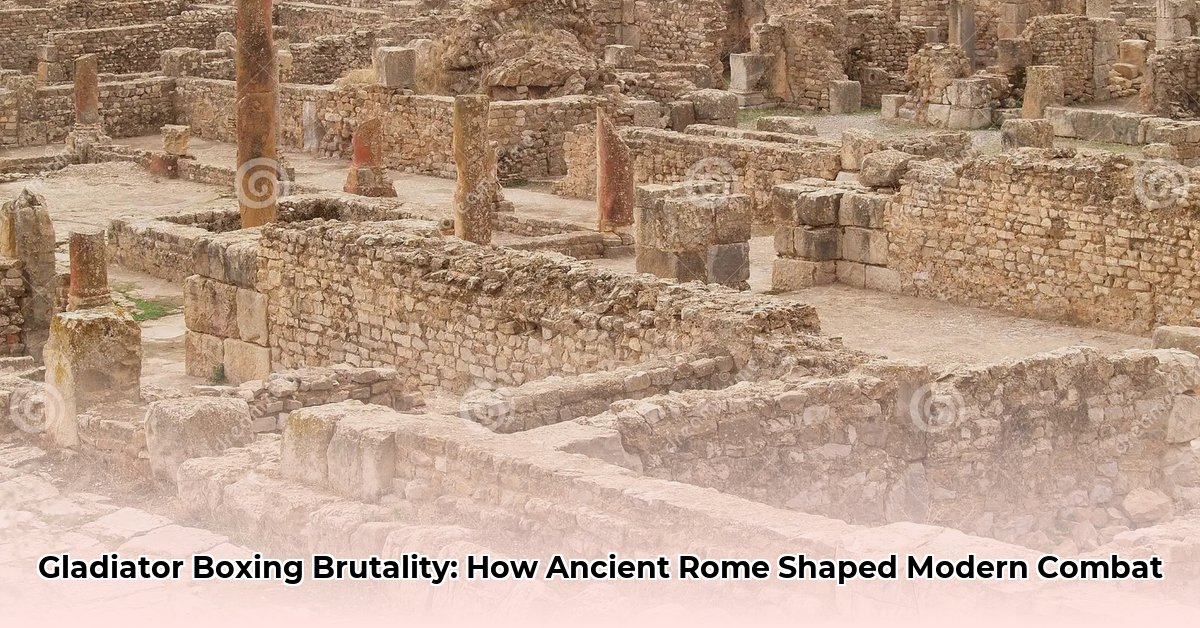Step into the tumultuous arenas of ancient Rome, where combat transcended mere sport to become a visceral spectacle, a reflection of the empire’s unyielding spirit. This is the world of pugilatus, Roman boxing—a realm far removed from the padded gloves and structured rounds of today. Imagine the raw ferocity of gladiatorial combat, channeled through iron-clad fists, and you begin to grasp its profound impact on Roman society, its formidable equipment, and its stark contrast to modern combat sports. We will journey through its bloody origins, explore the dual purpose it served as entertainment and military training, and examine the motivations of the ancient fighters who embraced its brutal demands. Prepare to have your understanding reshaped as we uncover the complete, unvarnished history of Roman boxing and its enduring echoes in contemporary combat sports. Learn about famous gladiators of the time.
The Evolution of Roman Boxing: From Ancient Roots to Brutal Spectacle
Boxing, in its various forms, boasts an ancient lineage tracing back to 3rd-millennium BCE Mesopotamia. Early depictions, such as a terracotta relief from Eshnunna (c. 2000 BCE) showing two men with wrapped wrists ready to strike, confirm its status as a dignified sport even then. The Epic of Gilgamesh, too, hints at pugilism with a description of Gilgamesh battling a rival: “They seized each other, they bent down like expert[s], they destroyed the doorpost, the [wall] shook.” This evolution continued through Minoan, Hittite, and Egyptian art, eventually influencing the Greeks and Etruscans—the direct predecessors shaping Roman pugilatus.
While the Greeks emphasized athletic prowess and refined technique, the Etruscans often prioritized raw violence and spectacle. This distinct Etruscan influence laid a critical foundation for the Roman adaptation, which embraced a level of ferocity that set it apart. The Romans did not merely adopt; they transformed boxing into a uniquely Roman display, a powerful reflection of their core values and their pronounced inclination for the dramatic and the overtly violent.
The Escalation of Violence: Equipment and Its Impact
The specialized gear used by Roman fighters provides a striking perspective on the sport’s escalating brutality. Initially, boxers, following Greek tradition, utilized himantes—simple, thin strips of rawhide wrapped around the hand. These “light thongs,” as seen on Greek pottery from the 4th and 5th centuries BCE and even mentioned in Homer’s Iliad, were designed more to alleviate strain on hand muscles than for offense.
However, the Greeks also developed “sharp thongs”—denser, thicker leather with heavy casing around the knuckles, intended to deal serious damage. The most famous example is depicted in the Hellenistic statue, The Boxer at Rest, excavated near the Baths of Constantine in Rome. This statue, dating to the 1st century BCE, is a poignant testament to the toll of the sport, showing a battered, exhausted boxer. The Romans adopted this aggressive Greek design but took it to an unprecedented level of savagery with the introduction of the caestus.
The caestus was not merely a glove; it was a weapon. Unlike modern boxing gloves, which prioritize safety, the caestus was engineered for destruction. The Roman poet Virgil, in his epic Aeneid, chillingly described them as “seven huge oxhides, all stiff with insewn lead and iron” (Virgil, Aeneid, 5.404-05). These formidable, metal-reinforced gloves transformed the sport into a brutal contest of raw, unyielding power, where debilitating, often deadly, blows were the grim and expected norm. Some depictions even show caesti with protruding spikes or blades, as seen in a 3rd-century CE Roman mosaic from the Baths of Caracalla. A recent archaeological discovery, two leather hand wrappings found in Hexham, Northumberland (c. 120 CE), further reinforce the practicality and widespread use of such equipment, even by the Roman military.
Roman Boxing Techniques: A Clash of Power, Not Finesse
Given the destructive nature of the caestus, ancient Roman boxing techniques centered on raw physical power and effective, devastating strikes. Unlike modern boxing, which emphasizes agility, intricate strategies, and refined footwork, pugilatus focused on delivering forceful punches and executing evasive maneuvers, primarily aiming for a swift knockout or compelling their opponent into submission.
Matches lacked structured rounds and continued relentlessly until one fighter was completely unable to proceed, often due to traumatic injuries. As described by Philo of Alexandria (1st century CE), a proficient boxer would “push away the punches coming at him with both hands and bend his neck this way and that, guarding against being struck.” Footwork involved quick, small steps, feints, and shifting between the knees, not unlike modern boxing. However, the ancient technique often involved extending the left arm straight forward as a guard while using the back arm for hooks and uppercuts. This opened the body significantly sideways, a stance that would be disastrous in modern boxing. This open stance was effective in antiquity because body blows were far less common. Instead, direct headshots, including even more cuts that are illegal today, were primary objectives. A popular illegal head blow was thrown from above, as Virgil described in the Aeneid: “Then Entellus, rising, put forth his right [fist], lifted high; the other speedily foresaw the down-coming blow.”
The match ended when one opponent tapped out or was knocked out. Tapping out was signaled by holding up a hand, often a single index finger, a practice depicted on Greek vases. Homer’s Iliad provides an example of a knockout when Epeus takes down Euryalus with a “smashing roundhouse hook to the head—a knockout blow!” (Homer, Iliad, 23.768).
One significant difference from modern combat sports was the virtual absence of weight classes. Big and small men frequently fought each other, as evidenced in literature and artwork. Theocritus, for instance, noted Polydeuces was much larger than Amytus, yet the smaller man could still win through superior technique. Formalized rings were also rare; contests typically took place in open-air courtyards or the designated halls of large bathhouses. What truly set Roman boxing apart was its uncompromising brutality and a strategic focus on incapacitating hits over points-based victories.
A Dualistic Role: Entertainment and Military Training
Ancient Roman boxing fulfilled two distinct, yet interconnected, functions within Roman society. As a form of grand public entertainment, these physically demanding matches were staged in magnificent arenas, not necessarily limited to the Colosseum, and in more intimate private venues. Both affluent patrons and ordinary citizens enthusiastically attended these events. Emperor Augustus (ruled 27 BCE – 14 CE) was known to be an ardent lover of boxing, meticulously recorded by Suetonius (c. 69 – c. 130/140 CE), who wrote that Augustus “loved to watch athletes compete, Roman or Greek.” These games often included exotic performances and elaborate banquets, serving as a powerful tool to entertain and sometimes to divert public attention during periods of political or social unrest.
Concurrently with its role as entertainment, pugilatus also served a vital purpose as a tool for military preparation. Intense hand-to-hand drills meticulously honed soldiers’ combat capabilities for close-quarters battles. By enduring the pain and physical fatigue inherent in boxing, soldiers were more effectively prepared to face the extreme rigors and unpredictable nature of pitched battle. This dual utility highlights the Roman pragmatic view of physical prowess: strength and resilience cultivated in the arena were directly applicable on the battlefield.
Risks, Injuries, and Societal Concerns
The violence inherent in ancient Roman boxing resulted in consistently rampant and strikingly severe injuries. Bruising, edemas, hematomas, cauliflower ear, fractures (especially to the nose), cranium-brain bruising leading to severe disability from cerebral hemorrhage, loss of teeth, and even death were tragically common occurrences. Many of these effects became lifelong deformities that ancient medical technology could not cure. The Greek physician Galen (2nd-3rd centuries CE), observed the long-term toll on athletes, stating that as they grew old, they “creep, wrinkle and squint due to the severe blows; their eyes are filled with catarrhal liquids, their teeth fall, and their bones become porotic and break easily.” (Galen, The Art of Medicine, 11). Etruscan funerary wall paintings, such as the Tomb of the Augurs (c. 540-530 BCE), even depict a “Phersu game” with a bound man being bitten by a dog, bleeding from multiple areas, underscoring the Etruscan fondness for extreme violence that influenced Roman tastes.
Despite its popularity, Roman boxing faced significant criticism and moral reservations. Some Roman intellectuals, like Tacitus (c. 56 – c. 118 CE), voiced concerns that recreational fighting might unjustly overshadow and ultimately undermine the profound importance of serious military training, a cornerstone of Roman power. They believed that the structured discipline of traditional military exercises was inherently more beneficial than the chaotic nature of boxing matches.
The pervasive rise of Christianity also contributed significantly to its long-term decline. Early Christians often viewed the games as barbaric and associated them with pagan traditions. The final blow came in 393 AD, when Emperor Theodosius I formally banned the Olympic Games, citing both their overt violence and their ingrained pagan roots. This pivotal decision decisively marked the categorical end of the era of formalized Roman boxing, revealing significant shifts in perspective within Roman society regarding the societal acceptability of extreme violence.
The Enduring Legacy of Pugilatus
Despite its eventual decline and formal prohibition, the enduring spirit of ancient Roman boxing continues to resonate within modern combat sports. The fundamental emphasis on physical strength, strategic agility, and robust technique remains strikingly relevant across various contemporary disciplines. The underlying concept of boxing as a display of personal courage and profound resilience persists in sports like mixed martial arts (MMA), serving as a powerful reminder that even the most brutal historical aspects of human endeavor can profoundly shape the athletic competitions that captivate audiences today.
Archaeological findings, evocative artistic depictions, and numerous profound literary references collectively offer invaluable insights into its brutal evolution and its complex role within the vast Roman Empire. Roman boxing provides a crucial glimpse into the core values, popular entertainment forms, and rigorous military practices of ancient Rome, illuminating the indelible human spirit that continues to compete and endure across millennia.
| Feature | Ancient Roman Boxing (Pugilatus) | Modern Boxing |
|---|---|---|
| Origins | Mesopotamia, Greece, Etruria (key influence) | Bare-knuckle brawling, formalized by 18th/19th century British rules (e.g., Queensberry) |
| Key Equipment | Caestus (leather straps reinforced with lead, iron, or spikes) | Padded gloves, mouthguards, hand wraps, headgear (amateur) |
| Match Structure | No rounds; fights continued until knockout or submission (raising index finger) | Defined rounds (e.g., 3 minutes each, 1-minute rest); timed bouts |
| Rules & Governance | Few formal rules; no weight classes, no formalized rings; referee with a switch | Strict rules, weight classes, regulated rings, judges, extensive safety protocols |
| Primary Techniques | Primarily head blows, cuts common, forceful strikes from above; less body blows | Diverse techniques, emphasis on strategy, body blows, jabbing, hooks, uppercuts |
| Injuries & Fatality | Extremely high risk; severe fractures, brain damage, disfigurement, death common | High but regulated; concussions, cuts, but significantly reduced fatality |
| Social Context & Purpose | Grand public entertainment, rigorous military training, demonstration of brutality | Competitive sport, professional athleticism, fitness, skill, and strategy |
| Decline | Banned in 393 AD (Emperor Theodosius I) due to violence and pagan associations | Endured, evolved into a globally popular and regulated sport |










